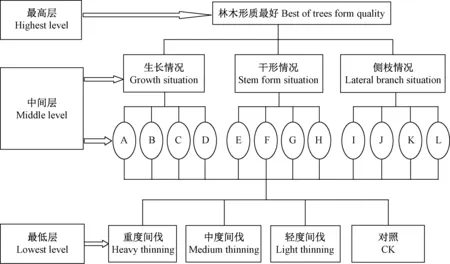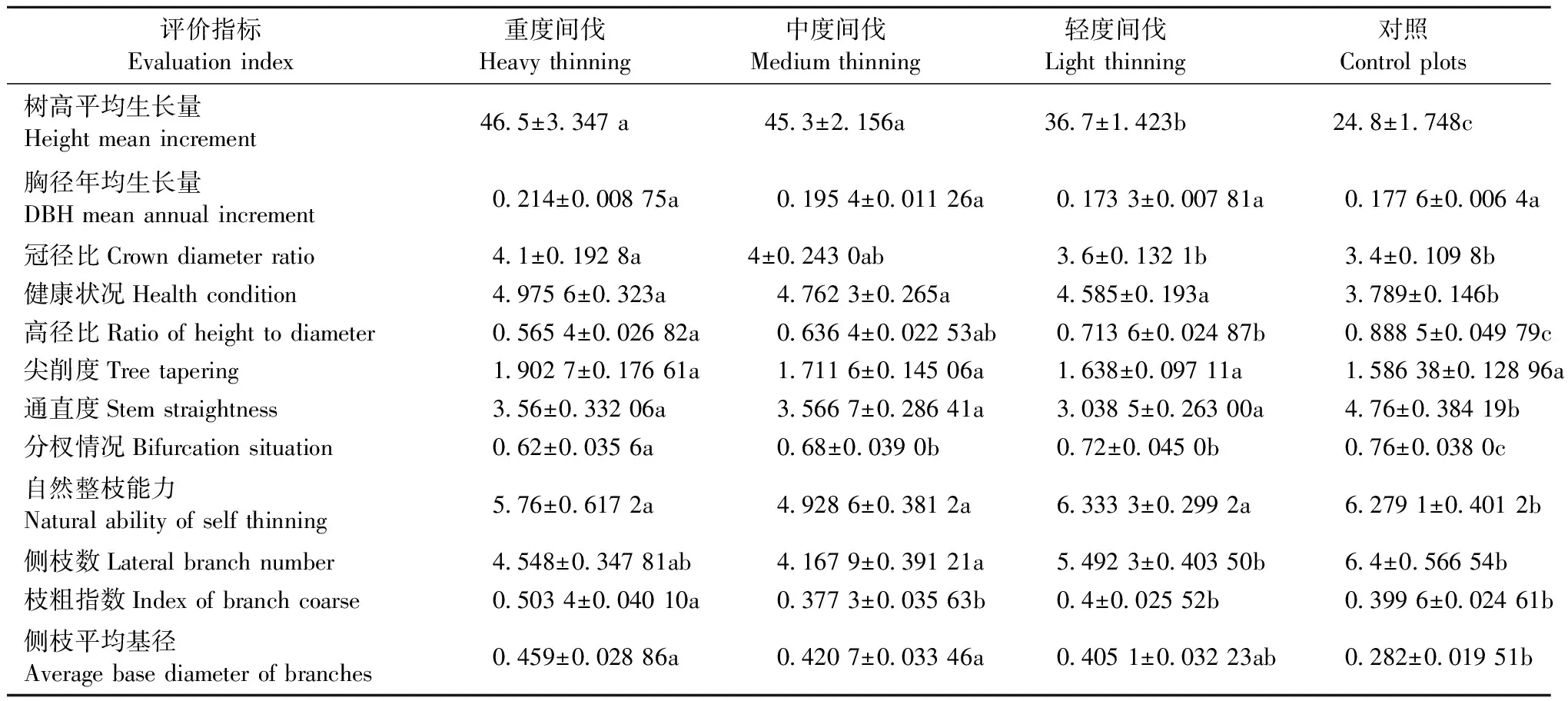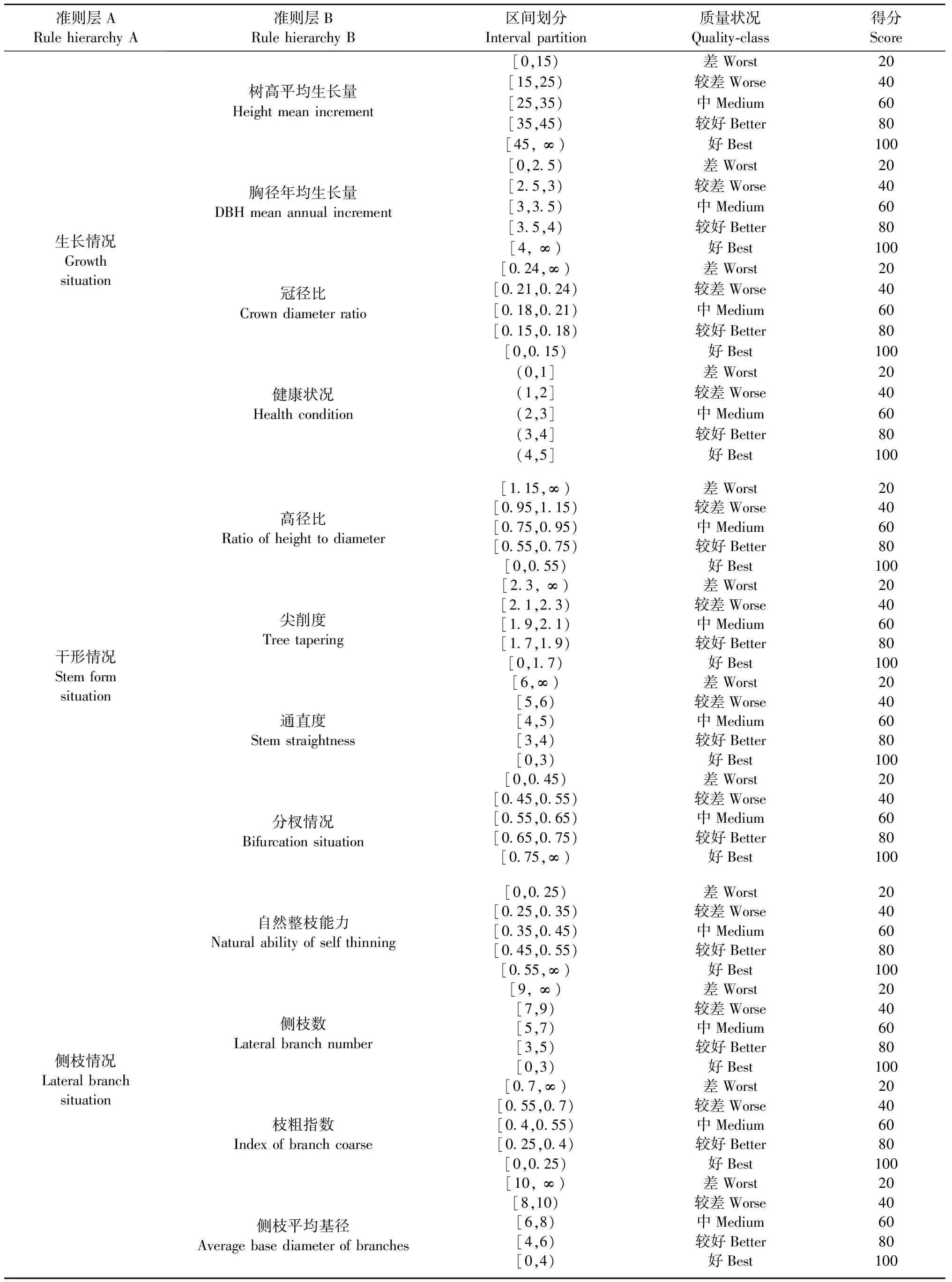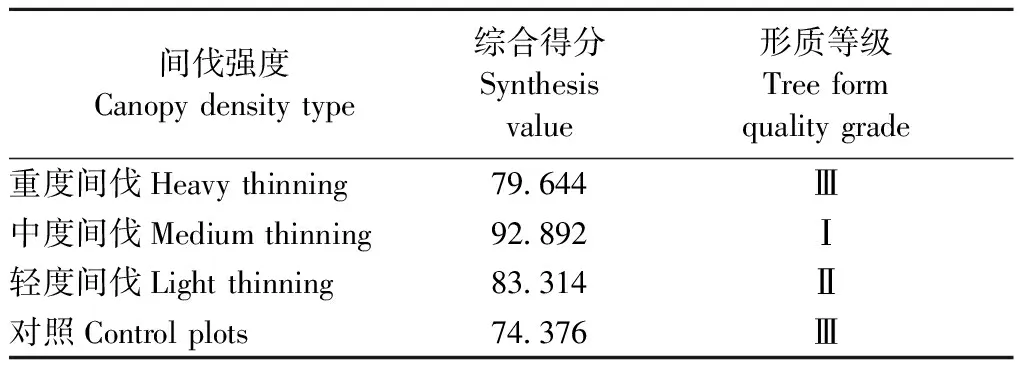抚育间伐对黄龙山辽东栎林木形质的影响*
2017-12-15于世川张文辉尤健健黄财智邢忠利樊蓉蓉西北农林科技大学陕西省林业综合实验室杨凌712100
于世川 张文辉 尤健健 邓 磊 黄财智 邢忠利 樊蓉蓉 何 婷(西北农林科技大学陕西省林业综合实验室 杨凌 712100)
抚育间伐对黄龙山辽东栎林木形质的影响*
于世川 张文辉 尤健健 邓 磊 黄财智 邢忠利 樊蓉蓉 何 婷
(西北农林科技大学陕西省林业综合实验室 杨凌 712100)
【目的】 研究抚育间伐对黄龙山辽东栎林木形质的影响,为林木形质评价体系、黄土高原辽东栎抚育间伐提供理论依据。【方法】 在黄土高原黄龙山林区辽东栎林设置抚育间伐试验样地,开展重度(保留郁闭度0.6)、中度(保留郁闭度0.7)和轻度(保留郁闭度0.8)间伐,同时设置对照样地(郁闭度0.9)。为了保持郁闭度不变,每隔3年进行1次抚育间伐。以生长情况(树高平均生长量、胸径年均生长量、冠径比、健康状况)、干形情况(高径比、尖削度、通直度、分杈情况)和侧枝情况(自然整枝能力、侧枝数、枝粗指数、侧枝平均基径)作为辽东栎林木形质评价指标,运用层次分析法构建辽东栎林木形质评价体系,对3种抚育间伐强度(重度、中度、轻度间伐)与对照下辽东栎林木形质进行综合评价。【结果】 干形情况对辽东栎林木形质的影响最大,贡献率占0.653; 生长情况对其影响次之,贡献率占0.285; 侧枝情况对其影响较小,贡献率仅占0.062; 12个评价指标在辽东栎林木形质评价中的权重大小依次为: 通直度(0.344 6)gt;分杈情况(0.227 1)gt;健康状况(0.190 7)gt;胸径年均生长量(0.051 3)gt;高径比(0.046 3)gt;自然整枝能力(0.037 7)gt;尖削度(0.035 2)gt;树高平均生长量(0.031 6)gt;侧枝平均基径(0.012 6)gt;冠径比(0.011 4)gt;枝粗指数(0.008 9)gt;侧枝数(0.003 0); 综合评价得分依次为: 中度间伐(92.892)gt;轻度间伐(83.314)gt;重度间伐(79.644)gt;对照(74.376),林木形质得分随间伐强度增加先增加后减少,中度间伐得分最高,林木形质最好。【结论】 抚育间伐可改善辽东栎林木形质,评价指标树高平均生长量、健康状况随间伐强度增加而增加,高径比随间伐强度增加而减少; 与对照相比,中度、重度间伐对冠径比、侧枝数、侧枝平均基径影响显著,间伐对通直度、分杈情况有显著影响; 中度间伐(保留郁闭度0.7)对改善辽东栎林木形质的作用最大,轻度间伐(保留郁闭度0.8)次之,重度间伐(保留郁闭度0.6)最小,可为黄土高原辽东栎抚育间伐技术提供依据。利用层次分析法构建辽东栎林木形质评价体系,可为其他树种形质评价提供借鉴。
抚育间伐; 形质评价; 层次分析法; 辽东栎
抚育间伐是指在林分郁闭后直至主伐期间,对未成熟的森林定期而重复地伐去部分林木,为保留的林木创造更好的生长环境条件,同时获取一部分木材的一种森林培育技术措施(沈国舫等, 2011)。通过抚育间伐,可清除劣质林木,调整树种组成,改善林分卫生状况,促进林木生长,提高林木质量,建立适宜的林分结构,发挥森林多种效益(周建云等, 2012)。
国内外的抚育间伐研究多集中在林木生长(Primiciaetal., 2016; Kuehneetal., 2015; Diaconuetal., 2015; Newton, 2015; 周建云等, 2012; 韩文娟等, 2013; 龚固堂等, 2015)、材质(Lowelletal., 2012;tefaníketal., 2014; 周崟等, 1980; 童雀菊等, 2005)、林分结构(Sullivanetal., 2016; Yücesanetal., 2015; 周建云等, 2012)、林下植物多样性(Hedo de Santiagoetal., 2016; 马履一等, 2007; Haughianetal., 2016)、水源涵养(翟凯燕等, 2015; 贾忠奎等, 2012)、土壤性质(成向荣等, 2010; 张建国等, 2012; 柳思勉等, 2015)、碳贮量与分配(方晰等, 2010; 明安刚等, 2013)等方面,而对林木形质的研究罕见报道,仅见尤健健等(2015)对不同郁闭度下油松(Pinustabulaeformis)林木形质进行了研究。
层次分析法是将一个复杂问题看成一个系统,将定性问题定量化,通过分析复杂问题所包含的元素及其相互关系,进而选择解决问题的最佳措施(王乃江等, 2010; 彭舜磊等, 2011; 陈俊华等, 2012; 国政等, 2013)。层次分析法在林业上的应用主要集中在树种选择(柳新红等, 2006)、种源选择(蒋艾平等, 2015)、自然度评价(彭舜磊等, 2011; 赵中华等, 2011)和生态系统效益评价(郑景明, 2003)等方面。
辽东栎(Quercuswutaishanica)为壳斗科(Fagaceae)栎属(Quercus)植物,是黄土高原地区主要建群种之一,形成了辽东栎纯林和以辽东栎为优势种的落叶阔叶混交林,作为生态公益林,其对该区水源涵养、水土保持和防风固沙发挥着重要生态功能(Xiaoetal., 2004; 周建云等, 2012)。同时,辽东栎也可为当地提供木材,是培养食用菌的主要原料,种子可以酿酒,叶子可以养蚕,具有重要经济价值(张志翔, 2008)。目前,辽东栎经营多集中在其生长发育、结构组成、竞争关系等单方面研究,缺乏对其综合评价的报道,培育高品质、大径级林木对辽东栎林发挥生态效益与经济效益具有重要意义。鉴于此,本研究采用层次分析法对辽东栎林木形质指标进行综合评价,研究不同抚育间伐强度对辽东栎林木形质的影响,为林木形质评价体系、黄土高原辽东栎抚育间伐提供理论依据。
1 研究区概况与研究方法
1.1 研究区概况
研究区选择在陕北黄土高原延安市黄龙山林业局蔡家川林场,地理位置109°38′49—110°12′47″E,35°28′46″—36°02′01″N,海拔 962.6~1 783.5 m,属暖温带半湿润与半干旱气候的过渡地带,年均气温8.6 ℃,最高气温36.7 ℃,最低气温-22.5 ℃,无霜期 126~186天,年均降水量611.8 mm。该林区属暖温带落叶阔叶林,以辽东栎、油松、白桦 (Betulaplatyphylla) 为建群种形成的纯林或混交林呈镶嵌性分布,并伴有茶条槭 (Acerginnala)、山杨 (Populusdavidiana)、漆(Toxicodendronvernicifluum)、鹅耳枥(Carpinusturczaninowii)等树种;灌木层主要有华北绣线菊 (Spiraeafritschiana)、胡枝子(Lespedezabicolor)、虎榛子(Ostryopsisdavidiana)、陕西荚蒾(Viburnumschensianum)、灰栒子(Cotoneasteracutifolius)、金银忍冬(Loniceramaackii)、黄刺玫(Rosahugonis)等;草本层主要有大披针薹草(Carexlanceolata)、白茅(Imperatacylindrica)、披碱草(Elymusdahuricus)等(李荣等, 2011; 邓磊等, 2011; 尤健健等, 2015)。
研究区辽东栎为天然次生林,抚育前,林分表现为纯林多、密度大、生长不良,劣质木、病虫木比例大; 林分基本郁闭,由于郁闭后竞争作用和自然稀疏,使林分基本维持郁闭度0.9左右。2004 年实施间伐作业,以近自然经营理念为指导,对林地进行目标树单株经营,选择培养目标树,采取间密留匀、留优去劣间伐原则,使林木分布均匀,林分结构更为合理,提升林分质量。为了比较间伐强度对林木形质的影响,本研究采取3种间伐强度,包括重度(保留郁闭度0.6)、中度(保留郁闭度0.7)、轻度(保留郁闭度0.8)抚育间伐,同时设置对照样地(郁闭度0.9)。为了保持郁闭度不变,每隔3年进行1次抚育间伐,共抚育间伐3次。本研究所用数据为2004年设置对照与间伐样地的调查数据和2014年样地监测数据。
1.2 研究方法
1.2.1 样地设置与调查 2004年对辽东栎林进行充分踏查发现,辽东栎在阴坡长势明显好于阳坡,故在蔡家川林场143林班的阴坡、半阴坡,通过典型取样,共设置20 m×20 m样地12个(其中3个样地为对照样地),每个间伐强度(保留郁闭度0.6、0.7、0.8)各设置3个样地,并对设置不同间伐强度的样地进行作业,对照样地不作业。样地间伐前基本情况见表1。
对样地辽东栎进行林木形质指标调查,包括树高、胸径、冠幅、树干基径、树干中央直径、通直度、枝下高、侧枝数(基径≥1.5 cm)、侧枝基径、分杈高度和有无病虫害。

表1 辽东栎调查样地间伐前(2004年)基本特征Tab.1 Stand characteristics of the plots before thinning of the studied Q.wutaishanica forest in 2004
1.2.2 形质指标 形质指标(孟宪宇, 2006; 陈晓阳等, 2005; 尤健健等, 2015)包括:
1) 树高平均生长量: 树高年均生长量以新梢生长量代替。
2) 胸径年均生长量: 胸径年均生长量θ10=(DBH2014-DBH2004)/10,式中: DBH2014为2014年胸径测量值,DBH2004为2004年胸径测量值。
3) 冠径比: 冠径比为树冠指标,冠径比=树冠直径/胸径。
4) 健康状况: 根据树木有无病害、枯死程度,按健康、较健康、一般、不健康和非常不健康分5级,分别记为5、4、3、2和1分,分数越高越健康。
5) 高径比: 高径比=树高/胸径。
6) 尖削度: 尖削度=(树干基部直径 -树干中央直径)/0.5树高。
7) 通直度: 根据树干弯曲数目确定。
8) 分杈情况: 分杈情况=分杈高度/树高。
9) 自然整枝能力: 自然整枝能力=枝下高/树高。
10) 侧枝数: 调查基径大于1.5 cm的侧枝个数。
11) 枝粗指数: 反映树冠主枝粗细,枝粗指数=最粗枝基径/胸径。
12) 侧枝平均基径: 各侧枝基径的均值。
1.2.3 形质评价体系建立 基于形质指标与层次分析法的基本原理,将辽东栎形质评价体系分为有隶属关系的3层递阶层次结构(图1),分别为:
最高层: 表示解决问题的目的,即AHP所要达到的目标——林木形质最佳(刘豹等, 1984)。
中间层: 包括为实现目标所涉及的中间环节,由若干个层次组成。本研究分为2个层次: 准则层A为生长情况、干形情况和侧枝情况; 准则层B为树高平均生长量、胸径年均生长量、冠径比、健康状况、高径比、尖削度、通直度、分杈情况、自然整枝能力、侧枝数、枝粗指数和侧枝平均基径。
最低层: 表示为实现目标可供选择的各种措施、决策、方案等,又称为措施层或方案层,即重度间伐、中度间伐、轻度间伐和对照(刘豹等, 1984)。

图1 辽东栎林木形质评价体系Fig.1 System of tree form quality evaluation of Q. wutaishanicaA: 树高平均生长量Height mean increment; B: 胸径年均生长量DBH mean annual increment; C:冠径比 Crown diameter ratio;D: 健康状况Health condition; E: 高径比Ratio of height to diameter; F:尖削度Tree tapering; G:通直度 Stem straightness; H:分杈情况 Bifurcation situation; I:自然整枝能力Natural ability of self thinning; J: 侧枝数Lateral branch number; K: 枝粗指数Index of branch coarse;L:侧枝平均基径 Average base diameter of branches.
1.2.4 判断矩阵构建 请专家根据理论和实践经验对各元素进行评价,将同一层次中两两元素间相对重要性给出一定尺度判断, 按照两元素A与B同等重要、A比B稍重要、A比B重要、A比B明显重要和A比B极端重要,分别以 1、3、5、7、9作为标度,以2、4、6、8表示相邻判断的中间值,用这些值的倒数表示2个元素的反比较,构建判断矩阵(Saaty, 1978; 王乃江等, 2010; 尤健健等, 2015),并求出矩阵最大特征根及其相应的特征向量,进行一致性检验,保证矩阵具有满意的一致性。
1.2.5 林木形质综合评价
式中:Ai为第i种间伐强度的林木形质综合评价得分;Xij为第i种间伐强度第j个指标所对应得分;Wj为第j个指标的权重(尤健健等, 2015)。
1.2.6 数据处理 采用Excel软件对原始数据进行初步整理和计算,SPSS20.0软件进行单因素方差分析(one-way ANOVA),用最小显著法(LSD)结合Duncan检验比较参数间差异性(α=0.05),采用Origin 8.1软件进行图表绘制。
2 结果与分析
2.1 建立判断矩阵并进行一致性检验
林木形质评价的判断矩阵、贡献率和CR见表2,生长情况、干形情况和侧枝情况的判断矩阵、贡献率和CR见表3、表4和表5,各判断矩阵随机一致性比率CR分别为0.070 7、0.085 7、0.047 4和0.067 5,均小于0.1,说明各判断矩阵具有满意的一致性,可用于权重计算。

表2 林木形质评价判断矩阵Tab.2 Determining matrix of trees form quality evaluation

表3 生长情况指标判断矩阵Tab.3 Determining matrix of growth situation

表4 干形情况指标判断矩阵Tab.4 Determining matrix of stem form situation

表5 侧枝情况指标判断矩阵Tab.5 Determining matrix of lateral branch situation
2.2 评价指标权重
采用高斯迭代法求解各层次上评价指标判断矩阵的最大特征根及其对应的特征向量,得到林木形质评价指标权重,见表6。由表2可看出,准则层A各指标权重为: 干形情况(0.653)gt;生长情况(0.285)gt;侧枝情况(0.062),说明干形情况对林木形质影响最大,生长情况对林木形质有一定影响,侧枝情况对林木形质影响较小。由表6可看出,准则层B各指标权重为: 通直度(0.344 6)gt;分杈情况(0.227 1)gt;健康状况(0.190 7)gt;胸径年均生长量(0.051 3)gt;高径比(0.046 3)gt;自然整枝能力(0.037 7)gt;尖削度(0.035 2)gt;树高平均生长量(0.031 6)gt;侧枝平均基径(0.012 6)gt;冠径比(0.011 4)gt;枝粗指数(0.008 9)gt;侧指数(0.003 0),通直度、分杈情况和健康状况对林木形质影响较大,胸径年均生长量、高径比、自然整枝能力、尖削度、树高平均生长量和侧枝平均基径对林木形质影响一般,冠径比、枝粗指数和侧枝数对林木形质影响较小。

表6 评价指标权重Tab.6 Relative weight of evaluating indicators
2.3 评价指标分级和林木形质等级
表7是对形质评价12个指标进行单因素方差分析的结果,可以看出,与对照相比,随着间伐强度增加,胸径年均生长量和尖削度增加,但尖削度增加不利于形质质量提高,且间伐强度对二者没有显著影响; 间伐强度对其他10个指标均有显著影响,树高平均生长量、健康状况和自然整枝能力随间伐强度增加而增加,高径比随间伐强度增加而减少,但均有利于形质质量提高; 与对照相比,轻度间伐对冠径比、侧枝数和侧枝平均基径影响不显著,但中度、重度间伐对其影响显著,轻度、中度间伐对枝粗指数影响不显著,重度间伐对其影响显著; 与对照相比,间伐对通直度和分杈情况有显著影响。
表7不同间伐强度与对照下辽东栎形质评价指标的情况
Tab.7ThesituationofQ.wutaishanicaformqualityevaluationindexwithdifferentthinningintensityandcontrolplots

评价指标Evaluationindex重度间伐Heavythinning中度间伐Mediumthinning轻度间伐Lightthinning对照Controlplots树高平均生长量Heightmeanincrement46 5±3 347a45 3±2 156a36 7±1 423b24 8±1 748c胸径年均生长量DBHmeanannualincrement0 214±0 00875a0 1954±0 01126a0 1733±0 00781a0 1776±0 0064a冠径比Crowndiameterratio4 1±0 1928a4±0 2430ab3 6±0 1321b3 4±0 1098b健康状况Healthcondition4 9756±0 323a4 7623±0 265a4 585±0 193a3 789±0 146b高径比Ratioofheighttodiameter0 5654±0 02682a0 6364±0 02253ab0 7136±0 02487b0 8885±0 04979c尖削度Treetapering1 9027±0 17661a1 7116±0 14506a1 638±0 09711a1 58638±0 12896a通直度Stemstraightness3 56±0 33206a3 5667±0 28641a3 0385±0 26300a4 76±0 38419b分杈情况Bifurcationsituation0 62±0 0356a0 68±0 0390b0 72±0 0450b0 76±0 0380c自然整枝能力Naturalabilityofselfthinning5 76±0 6172a4 9286±0 3812a6 3333±0 2992a6 2791±0 4012b侧枝数Lateralbranchnumber4 548±0 34781ab4 1679±0 39121a5 4923±0 40350b6 4±0 56654b枝粗指数Indexofbranchcoarse0 5034±0 04010a0 3773±0 03563b0 4±0 02552b0 3996±0 02461b侧枝平均基径Averagebasediameterofbranches0 459±0 02886a0 4207±0 03346a0 4051±0 03223ab0 282±0 01951b
结合单因素方差分析结果与12个指标具体数值波动范围,将各指标划分为5个区间,表示5个质量等级,根据各形质指标表达的生物学意义,按百分制给质量等级赋值,质量等级依次用好、较好、中、较差和差表示,对应得分依次为100、80、60、40和20(表8)。
依据表9对辽东栎林木形质综合得分计算并划分等级,≥90分,林木形质好,记为Ⅰ级; 80~90分,林木形质较好,记为Ⅱ级; 70~80分,林木形质中等,记为Ⅲ级; 60~70分林木形质较差,记为Ⅳ级; lt;60分,林木形质差,记为Ⅴ级。中度间伐的辽东栎林木形质好,综合得分达92.892,轻度间伐的辽东栎林木形质较好,重度间伐和对照的辽东栎林木形质中等。与对照相比,随着间伐强度增加,辽东栎林木形质先增加后减少,中度间伐是其最佳间伐强度。

表8 林木形质评价指标等级及评分标准Tab.8 Criteria and indicator interval partition,quality class and scores for tree form quality evaluation

表9 林木形质综合得分及形质等级Tab.9 Tree form synthesis value and quality grade
3 讨论
干形情况对辽东栎林木形质影响最大,生长情况次之,侧枝情况最小,说明干形对林木形质起主要作用,这符合用材林的实际情况。在12个指标中,通直度、分杈情况、健康情况对林木形质的影响起主要作用,林木越通直、无分杈或分杈处越高,其干形质量越好,形质质量越高; 林木无病虫害、无枯死,其生长健康,形质质量好。
由于抚育间伐,去劣留优,促进了林下植被生长,提高了林木整体质量,增加了林内光照强度,使林木能充分进行光合作用,但林木自然整枝能力变弱,枝下高降低; 同时,林内光照增强,导致林内、林地温度升高,林木生理生化反应加快,生长发育加速,且林地温度增加,利于林木从土壤中吸收水分并加快土壤有机质分解,增加土壤肥力,利于林木生长(薛建辉, 2006; 韩文娟等, 2013; 龚固堂等, 2015),因此与对照相比,抚育间伐森林的健康状况、树高平均生长量、胸径年均生长量和尖削度增加。但间伐对胸径年均生长量、尖削度增加影响不显著,可能因为林分是异龄林,各龄级林木的胸径生长对间伐响应不同,不同间伐强度之间差异不明显,现有间伐量对胸径生长影响还不够大。间伐强度对其他10个指标均有显著影响,因为随间伐强度增加,林内生境条件改善,适合林木生长,林木通直、分杈少,树冠能充分进行光合作用,新梢能快速生长; 轻度间伐林内生境变化小,冠径比、侧枝数、侧枝平均基径、枝粗指数和对照相比变化不明显,加大间伐强度,冠径比、侧枝数、侧枝平均基径会出现显著变化,枝粗指数在重度间伐才表现出显著变化。
中度间伐的辽东栎林木形质优于轻度间伐、重度间伐和对照,是因为重度间伐林内过于稀疏,有利于树冠生长,但不利于自然整枝,树干弯曲多,干形较差; 轻度间伐林内光照弱,部分个体在竞争中出现枯死,不利于林木生长(尤健健等, 2015); 而中度间伐为林内提供了适宜的光照条件,辽东栎能在优越的生境中生长。因此中度间伐所保留的郁闭度为辽东栎林木拥有高质量形质提供了较好生境,可以为黄土高原辽东栎抚育间伐提供借鉴。
作为试验样地,每3年抚育间伐1次,探索郁闭度对辽东栎林木形质的影响是必要的,但在集约经营程度不高的条件下,考虑抚育间伐经济效益,要做到每3年1个抚育间伐期是不现实的。本研究试验得出间伐强度(保留郁闭度)对林木形质的影响是存在的,因此,考虑黄土高原辽东栎林经营实际情况,以10年1个抚育间伐期在经营成本上可能更为合理。
目前,对林木形质指标的设定没有统一标准,各指标应占权重也没有统一规定,本研究选取的12个指标是在陈晓阳等(2005)、尤健健等(2015)研究基础上选取的比较直观、适合林业工作者调查的指标,能够较全面反映辽东栎林木生长、干形和侧枝情况,进而反映辽东栎林木形质情况。将树高平均生长量、胸径年均生长量代替树高、胸径划为形质指标,将分杈高度占树高比值作为分杈情况的赋分标准,能更合理地反映林木形质,同时以层次分析法评价林木形质可以将定性问题定量化、复杂问题简单化,但层次分析法主观性强,本研究在指标的选择与评价都经过了多个专家论证,因此该方法对辽东栎林木形质的评价是科学的,可以为评价林木形质提供进一步的理论依据。但是本研究选取的12个指标是林分调查获取的宏观数据,对木材化学性质、物理性质、力学性质等方面还有待进一步研究。
4 结论
抚育间伐可改善辽东栎林木形质质量,其中形质指标树高平均生长量、健康状况随间伐强度增加而增加,高径比随间伐强度增加而减少,但均有利于林木形质质量提高; 与对照相比,中度、重度间伐对冠径比、侧枝数、侧枝平均基径影响显著,间伐对通直度、分杈情况有显著影响; 中度间伐(保留郁闭度0.7)对改善辽东栎林木形质质量的作用最大,轻度间伐(保留郁闭度0.8)次之,重度间伐(保留郁闭度0.6)最小,可为黄土高原辽东栎抚育间伐技术提供依据。利用层次分析法构建辽东栎林木形质评价体系可以为其他树种形质评价提供借鉴。
陈俊华, 龚固堂, 朱志芳, 等.2012. 小流域防护林体系的空间对位配置. 林业科学, 48(2):38-47.
(Chen J H, Gong G T, Zhu Z F,etal. 2012. Spatial para allocation of a small watershed protection forest system. Scientia Silvae Sincae, 48(2):38-47. [in Chinese])
陈晓阳, 沈熙环. 2005. 林木育种学. 北京: 高等教育出版社.
(Chen X Y, Shen X H. 2005. Forest tree breeding. Beijing: Higher Education Press. [in Chinese])
成向荣, 冯 利, 虞木奎, 等.2010. 间伐对生态公益林冠层结构及土壤养分的影响. 生态环境学报, 19(2):355-359.
(Cheng X R, Feng L, Yu M K,etal. 2010. Effects of thinning on canopy structure and soil nutrient in ecological plantation. Ecology and Environmental Sciences, 19(2): 355-359. [in Chinese])
邓 磊, 张文辉, 何景峰, 等.2011. 不同采伐强度对辽东栎林幼苗更新的影响. 西北林学院学报, 26(2):160-166.
(Deng L, Zhang W H, He J F,etal. 2011. Effects of different cutting intensities on seedling regeneration ofQuercusliaotungensis. Journal of Northwest Forestry University, 26(2):160-166. [in Chinese])
方 晰, 田大伦, 项文化.2010. 间伐对杉木人工林生态系统碳贮量及其空间分配格局的影响. 中南林业科技大学学报, 30(11):47-53.
(Fang X, Tian D L, Xiang W H. 2010. Effects of thinning on carbon storage and its spatial distributions in Chinese fir plantation ecosystem. Journal of Central South University of Forestry amp; Technology, 30(11): 47-53. [in Chinese])
龚固堂, 牛 牧, 慕长龙, 等.2015. 间伐强度对柏木人工林生长及林下植物的影响.林业科学, 51(4):8-15.
(Gong G T, Niu M, Mu C L,etal. 2015. Impacts of different thinning intensities on growth ofCupressusfunebrisplantation and understory plants. Scientia Silvae Sincae, 51(4): 8-15. [in Chinese])
国 政, 臧润国. 2013. 中国极小种群野生植物濒危程度评价指标体系. 林业科学, 49(6):10-17.
(Guo Z, Zang R G. 2013. Evaluation index system of endangered levels of the wild plants with tiny population in China. Scientia Silvae Sincae, 49(6):10-17. [in Chinese])
韩文娟, 何景峰, 张文辉, 等.2013. 黄龙山林区油松人工林林窗对幼苗根系生长及土壤理化性质的影响. 林业科学, 49(11):16-23.
(Han W J, He J F, Zhang W H,etal. 2013. Effects of gap size on root growth of seedlings and soil physical and chemical properties inPinustabulaeformisplantation in the Huanglong forest. Scientia Silvae Sincae, 49(11): 16-23. [in Chinese])
贾忠奎, 温志勇, 贾 芳, 等.2012. 北京山区侧柏人工林水源涵养功能对抚育间伐的响应. 水土保持学报, 26(1):62-66,71.
(Jia Z K, Wen Z Y, Jia F,etal. 2012. Effects of thinning on water conservation ofPlatycladusorientalisplantation in Beijing mountain area. Journal of Soil and Water Conservation, 26(1): 62-66, 71. [in Chinese])
蒋艾平, 刘 军, 姜景民, 等. 2015.基于层次分析法的乐东拟单性木兰优良种源选择. 林业科学研究, 28(1):50-54.
(Jiang A P, Liu J, Jiang J M,etal. 2015. Excellent provenance selection ofParakmerialatungensisby analytic hierarchy process. Forest Research, 28(1):50-54. [in Chinese])
李 荣, 张文辉, 何景峰, 等.2011. 不同间伐强度对辽东栎林群落稳定性的影响. 应用生态学报, 22(1):14-20.
(Li R, Zhang W H, He J F,etal. 2011. Effects of thinning intensity on community stability ofQuercusliaotungensisforest on Loess Plateau. Chinese Journal of Applied Ecology, 22(1):14-20. [in Chinese])
刘 豹,许树柏,赵焕臣,等. 1984. 层次分析法——规划决策的工具. 系统工程, 2(2):23-30.
(Liu B, Xu S B, Zhao H C,etal. 1984. AHP―Planning decision-making tool. Systems Engineering, 2(2):23-30. [in Chinese])
柳思勉, 田大伦, 项文化, 等. 2015. 间伐强度对人工杉木林地表径流的影响. 生态学报, 35(17):5769-5775.
(Liu S M, Tian D L, Xiang W H,etal. 2015. The impacts of thinning intensity on overland flow in a Chinese fir plantation. Acta Ecologica Sinica, 35(17):5769-5775. [in Chinese])
柳新红, 王章荣. 2006. 浙西南速生工业原料林阔叶树种评价与选择研究. 林业科学研究, 19(4): 497-503.
(Liu X H,Wang Z R.2006. Evaluation and selection of broad leaved tree species for fast-growing industrial plantation in southwest Zhejiang. Forest Research, 19(4): 497-503. [in Chinese])
马履一, 李春义, 王希群, 等. 2007. 不同强度间伐对北京山区油松生长及其林下植物多样性的影响.林业科学, 43(5):1-9.
(Ma L Y, Li C Y, Wang X Q,etal. 2007. Effects of thinning on the growth and the diversity of undergrowth ofPinustabulaeformisplantation in Beijing mountainous areas. Scientia Silvae Sincae, 43(5): 1-9. [in Chinese])
孟宪宇. 2006. 测树学.3版. 北京: 中国林业出版社.
(Meng X Y. 2006. Forest mensuration.3rded. Beijing: China Forestry Publishing House. [in Chinese])
明安刚, 张治军, 谌红辉, 等. 2013. 抚育间伐对马尾松人工林生物量与碳贮量的影响. 林业科学, 49(10):1-6.
(Ming A G, Zhang Z J, Chen H H,etal. 2013. Effects of thinning on the biomass and carbon storage inPinusmassonianaplantation. Scientia Silvae Sincae, 49(10): 1-6. [in Chinese])
彭舜磊, 王得祥. 2011. 秦岭主要森林类型近自然度评价. 林业科学, 47(1):135-142.
(Peng S L, Wang D X. 2011. Naturalness assessment of the main forest communities in Qinling Mountains. Scientia Silvae Sincae, 47(1): 135-142. [in Chinese])
沈国舫,翟明普. 2011. 森林培育学. 北京:中国林业出版社.
(Shen G F, Zhai M P.2011.Silviculture. Beijing: China Forestry Publishing House. [in Chinese])
童雀菊, 张述垠. 2005. 抚育间伐对北美短叶松的生长及材质的影响.南京林业大学学报: 自然科学版, 29(6):73-76.
(Tong Q J, Zhang S Y. 2005. Effects of precommercial thinning on tree growth and stem quality in Jack Pine stands. Journal of Nanjing Forestry University:Natural Science Edition,29(6):73-76. [in Chinese])
王乃江, 张文辉, 同金霞, 等. 2010. 黄土高原蔡家川林场森林质量评价. 林业科学, 46(9):7-13.
(Wang N J, Zhang W H, Tong J X,etal. 2010. Forest quality evaluation in Caijiachuan state forest station on Loess Plateau. Scientia Silvae Sinicae, 46(9):7-13. [in Chinese])
薛建辉. 2006. 森林生态学. 北京:中国林业出版社.
(Xue J H. 2006. Forest ecology. Beijing: China Forestry Publishing House. [in Chinese])
尤健健, 张文辉, 邓 磊. 2015. 黄龙山不同郁闭度油松中龄林林木形质评价. 应用生态学报, 26(7):1945-1953.
(You J J, Zhang W H, Deng L. 2015. Evaluation of the tree form quality of middle-aged plantation under different canopy densities in Huanglong Mountains,northwest China. Chinese Journal of Applied Ecology, 26(7):1945-1953. [in Chinese])
翟凯燕,陈信力,马婷瑶,等.2015.间伐对杉木人工林土壤多酚氧化酶活性的影响.东北林业大学学报,43(7): 88-91.
(Zhai K Y, Chen X L, Ma T Y,etal. 2015.Effects of thinning on soil polyphenol oxidase activity in Chinese fir plantation. Journal of Northeast Forestry University, 43(7): 88-91.[in Chinese])
张建国, 李应罡, 徐新文, 等.2012. 间伐对塔里木沙漠公路防护林乔木状沙拐枣生长与土壤水盐分布的影响. 应用生态学报, 23(9):2377-2382.
(Zhang J G, Li Y G, Xu X W,etal. 2012. Effects of thinning onCalligonumarborescensgrowth and soil water-salt distribution in Tarim Desert Highway shelterbelt. Chinese Journal of Applied Ecology, 23(9):2377-2382. [in Chinese])
张志翔. 2008. 树木学.北方本. 北京:中国林业出版社.
(Zhang Z X. 2008. Dendrology. The north.Beijing: China Forestry Publishing House. [in Chinese]).
赵中华, 惠刚盈. 2011. 基于林分状态特征的森林自然度评价——以甘肃小陇山林区为例. 林业科学, 47(12):9-16.
(Zhao Z H,Hui G Y.2011. Forest naturalness evaluation method based on stand state characters:a case study of Gansu Xiaolongshan forests. Scientia Silvae Sincae, 47(12):9-16. [in Chinese])
郑景明, 姜凤岐, 曾德慧. 2003.长白山阔叶红松林生态价位分级与生态系统经营对策. 应用生态学报, 14(6):839-844.
(Zheng J M, Jiang F Q, Zeng D H.2003. Ecovalue level classification and ecosystem management strategy of broad-leaved Korean pine forest in Changbai Mountain. Chinese Journal of Applied Ecology, 14(6):839-844. [in Chinese])
周建云, 李 荣, 张文辉, 等.2012. 不同间伐强度下辽东栎种群结构特征与空间分布格局. 林业科学, 48(4):149-155.
(Zhou J Y, Li R, Zhang W H,etal.2012. Effects of thinning intensity on structure characteristics and spatial distribution ofQuercuswutaishanicapopulations.Scientia Silvae Sinicae, 48(4):149-155. [in Chinese])
周 崟, 卢鸿俊. 1980. 落叶松间伐幼龄材的材质及其造纸性质兼论短轮伐期的造林问题. 林业科学, 16(3):161-173,241.
(Zhou Y, Lu H J. 1980. A study on wood quality and paper-making properties of larch thinning juvenile wood and evaluation of short-rotation intensively cultured plantations.Scientia Silvae Sinicae, 16(3):161-173,241. [in Chinese])
Diaconu D, Kahle H P, Spiecker H. 2015. Tree-and stand-level thinning effects on growth of european beech (FagussylvaticaL.) on a northeast- and a southwest-facing slope in southwest Germany. Forests, 6(9): 3256-3277.
Haughian S R, Frego K A. 2016.Short-term effects of three commercial thinning treatments on diversity of understory vascular plants in white spruce plantations of northern New Brunswick. Forest Ecology and Management, 370: 45-55.
Hedo de Santiago J, Lucas-Borja M E, Wic-Baena C,etal. 2016.Effects of thinning and induced drought on microbiological soil properties and plant species diversity at dry and semiarid locations. Land Degradation amp; Development,27(4):1151-1162.
Kuehne C, Weiskittel A R, Fraver S,etal. 2015. Effects of thinning-induced changes in structural heterogeneity on growth, ingrowth, and mortality in secondary coastal Douglas-fir forests. Canadian Journal of Forest Research, 45(11): 1448-1461.
Lowell E C, Dykstra D P, Monserud R A. 2012.Evaluating effects of thinning on wood quality in southeast Alaska. Western Journal of Applied Forestry, 27(2): 72-83.
Newton P F. 2015.Quantifying growth responses of black spruce and jack pine to thinning within the context of density management decision-support systems. Open Journal of Forestry, 5(4): 409-421.
Primicia I, Artázcoz R, Imbert J B,etal. 2016. Influence of thinning intensity and canopy type on Scots pine stand and growth dynamics in a mixed managed forest. Forest Systems, 25(2): e57.
Saaty T L. 1978.Modeling unstructured decision problems—the theory of analytical hierarchies. Math Comput Simulation, 20(3):147 -158.
Sullivan T P, Sullivan D S. 2016. Acceleration of old-growth structural attributes in lodgepole pine forest: tree growth and stand structure 25 years after thinning. Forest Ecology and Management, 365: 96-106.
Xiao Z, Zhang Z, Wang Y. 2004.Dispersal and germination of big and small nuts ofQuercusserratain a subtropical broad-leaved evergreen forest. Forest Ecology and Management,195(1/2):141-150.
Yücesan Z, Özçelik S, Oktan E. 2015.Effects of thinning on stand structure and tree stability in an afforested oriental beech (FagusorientalisLipsky) stand in northeast Turkey. Journal of Forestry Research, 26(1): 123-129.
(责任编辑 石红青)
EffectofThinningonQuercuswutaishanicaTreesFormQualitybytheAnalyticHierarchyProcessinHuanglongMountains
Yu Shichuan Zhang Wenhui You Jianjian Deng Lei Huang Caizhi Xing Zhongli Fan Rongrong He Ting
(KeyComprehensiveLaboratoryofForestryinShaanxiProvince,NorthwestAamp;FUniversityYangling712100)
【Objective】 In this study,the effects of thinning onQuercuswutaishanicatrees form quality were investigated by the analytic hierarchy process in Huanglong Mountains in order to provide theoretical basis of trees form quality evaluation system and thinning onQ.wutaishanicaon Loess Plateau.【Method】 Experimental sample plots, which are the heavy thinning (keeping canopy density of 0.6), medium thinning (keeping canopy density of 0.7), light thinning(keeping canopy density of 0.8) and control plots (canopy density of 0.9) onQ.wutaishanicaforest in Huanglong Mountains of the Loess Plateau were set up. In order to keep invariant canopy density of different thinning intensities of the experimental sample plots, every three years proceed on a tending thinning. TheQ.wutaishanicaform quality evaluation system was constructed by using the analytic hierarchy process (AHP), with growth situation(height mean increment, DBH mean annual increment, crown diameter ratio, health condition), stem form situation (ratio of height to diameter, tree tapering, stem straightness, bifurcation situation), lateral branch situation (natural ability of self thinning, lateral branch number, index of branch coarse, average base diameter of branches) asQ.wutaishanicaform quality evaluation index, calculatedQ.wutaishanicatrees form quality scores of comprehensive evaluation with the heavy thinning (keeping canopy density of 0.6), medium thinning (keeping canopy density of 0.7), light thinning(keeping canopy density of 0.8) and control plots (canopy density of 0.9).【Result】 The stem form situation was the most significant influencing for the tree form quality with the relative contribution rate of 0.653, followed by growth situation, which influenced the tree form quality had the relative contribution rate of 0.285, the less influencing of lateral branch situation for the tree form quality with the relative contribution rate of 0.062. Weights with all the evaluation indexes ofQ.wutaishanicaform quality evaluation were in sequence of stem straightness (0.344 6) gt; bifurcation situation (0.227 1)gt; health condition (0.190 7) gt; DBH mean annual increment (0.051 3) gt;ratio of height to diameter (0.046 3) gt; natural ability of self thinning (0.037 7) gt; tree tapering (0.035 2) gt; height mean increment (0.031 6) gt; average base diameter of branches (0.012 6) gt; crown diameter ratio (0.011 4) gt; index of branch coarse (0.008 9) gt; lateral branch number (0.003 0); Comprehensive evaluation score was in sequence of medium thinning (92.892) gt; light thinning (83.314) gt; heavy thinning (79.644) gt; control plots (74.376), trees form quality score firstly increased and then decreased with the increase of thinning intensity so that medium thinning had the highest score and the form quality ofQ.wutaishanicawas the best.【Conclusion】Quercuswutaishanicatrees form quality were promoted by thinning, and the height mean increment and health condition of the form indexes increased with thinning intensity, and ratio of height to diameter decreased with increasing thinning intensity. Compared with the control, the medium thinning and heavy thinning had significant influence on the crown diameter ratio, lateral branch number and average base diameter of branches.The thinning had significant influence on the stem straightness and bifurcation situation. The best thinning intensity for form quality ofQ.wutaishanicawas medium thinning (keeping canopy density of 0.7), followed by the light thinning(keeping canopy density of 0.8), the heavy thinning (keeping canopy density of 0.6) being the last,which should be suitable for application inQ.wutaishanicaforest tending thinning. With AHP to establish the trees form quality evaluation system can provide the basis for other species form quality evaluation.
tending thinning; form quality evaluation; analytic hierarchy process;Quercuswutaishanica
10.11707/j.1001-7488.20171112
2016-01-29;
2016-10-24。
杨凌示范区科技推广能力提升项目 “水保型栎林目标树经营技术示范”(2015-TS-29);国家林业局全国森林经营基础研究项目“全国森林经营样板基地典型经营模式及成效监测研究与示范”(1692016-03)。
*张文辉为通讯作者。
S753
A
1001-7488(2017)11-0104-10
